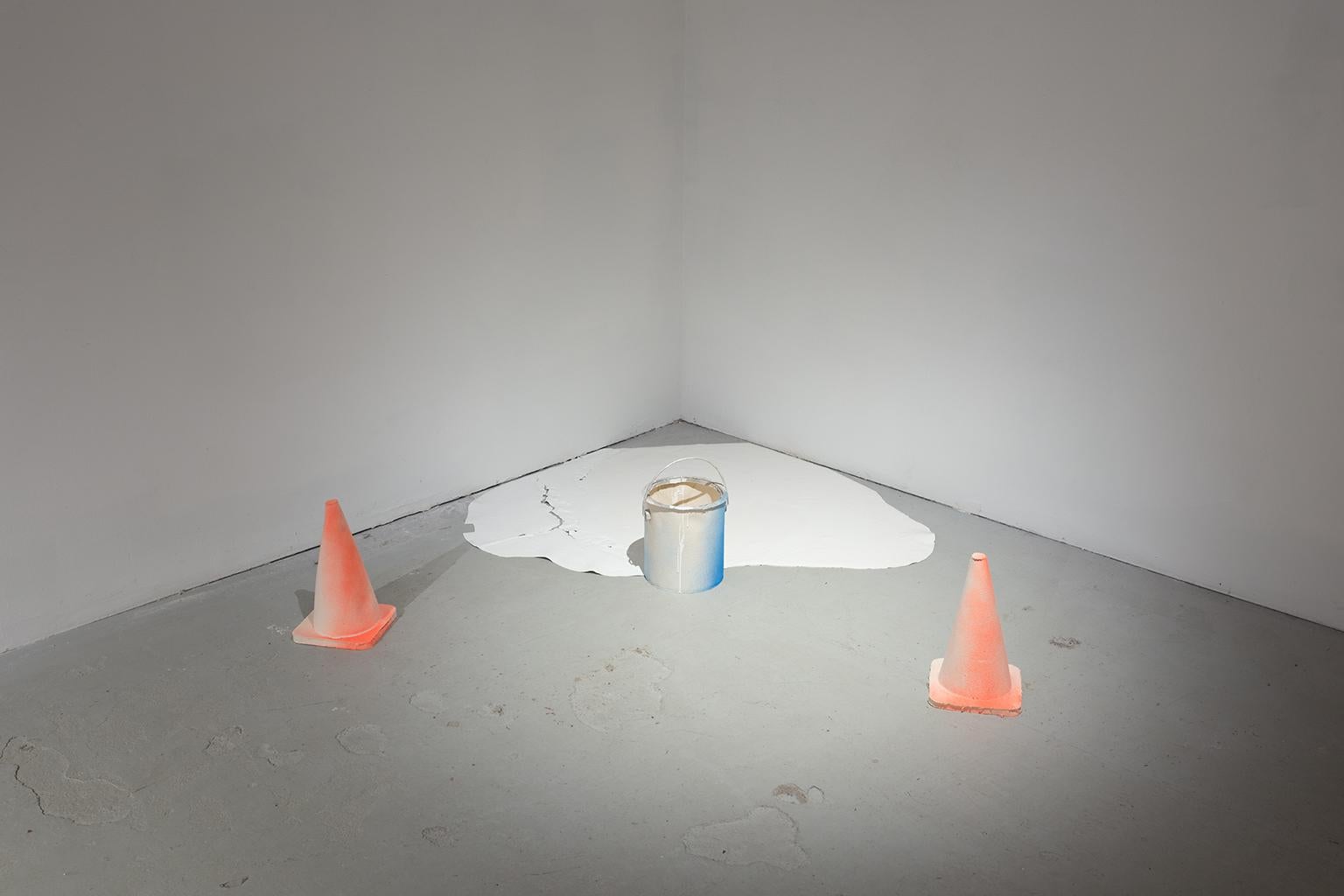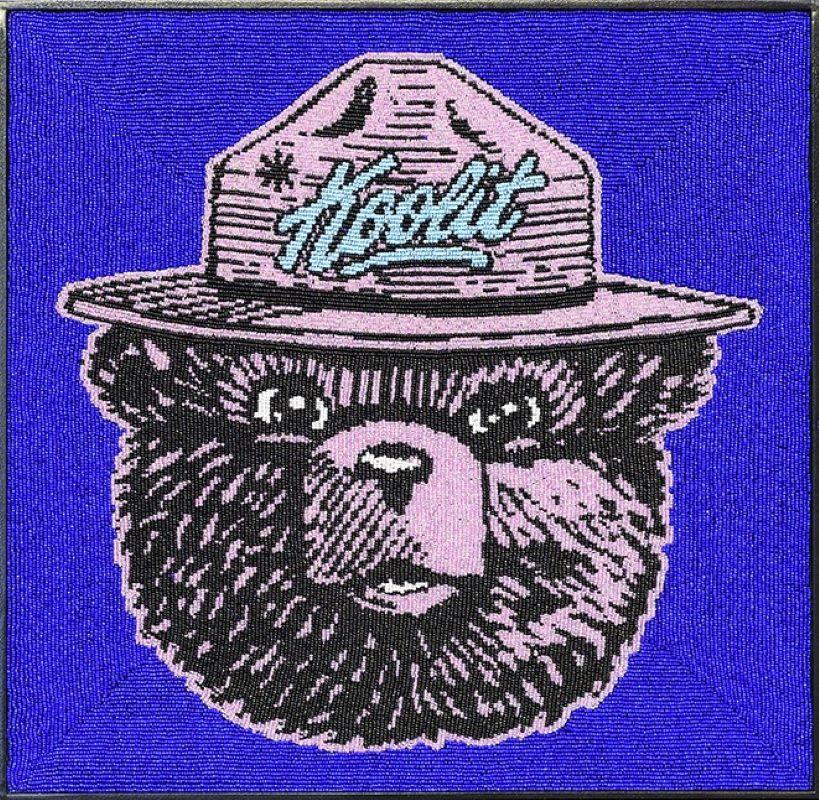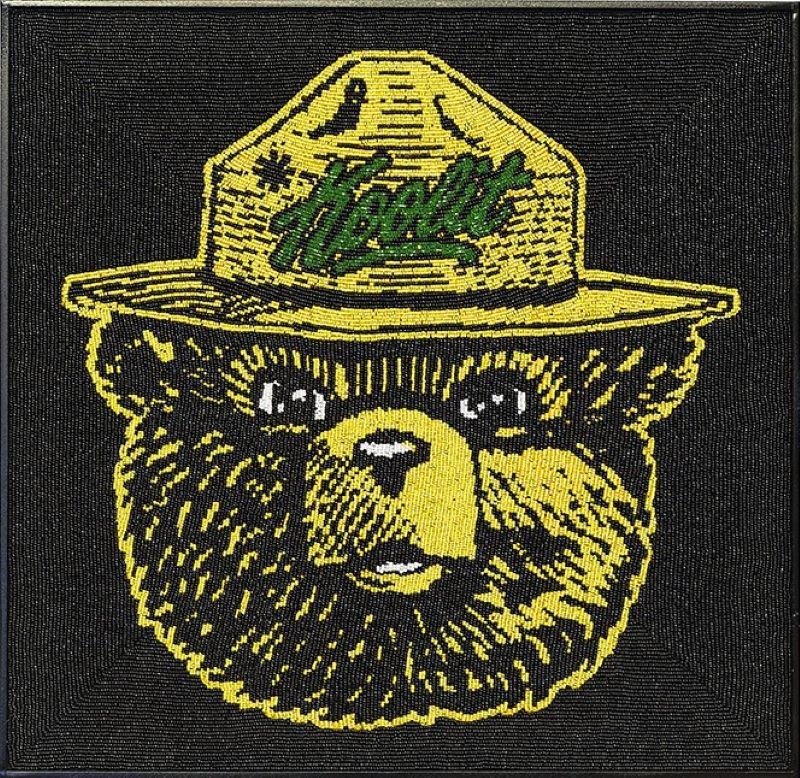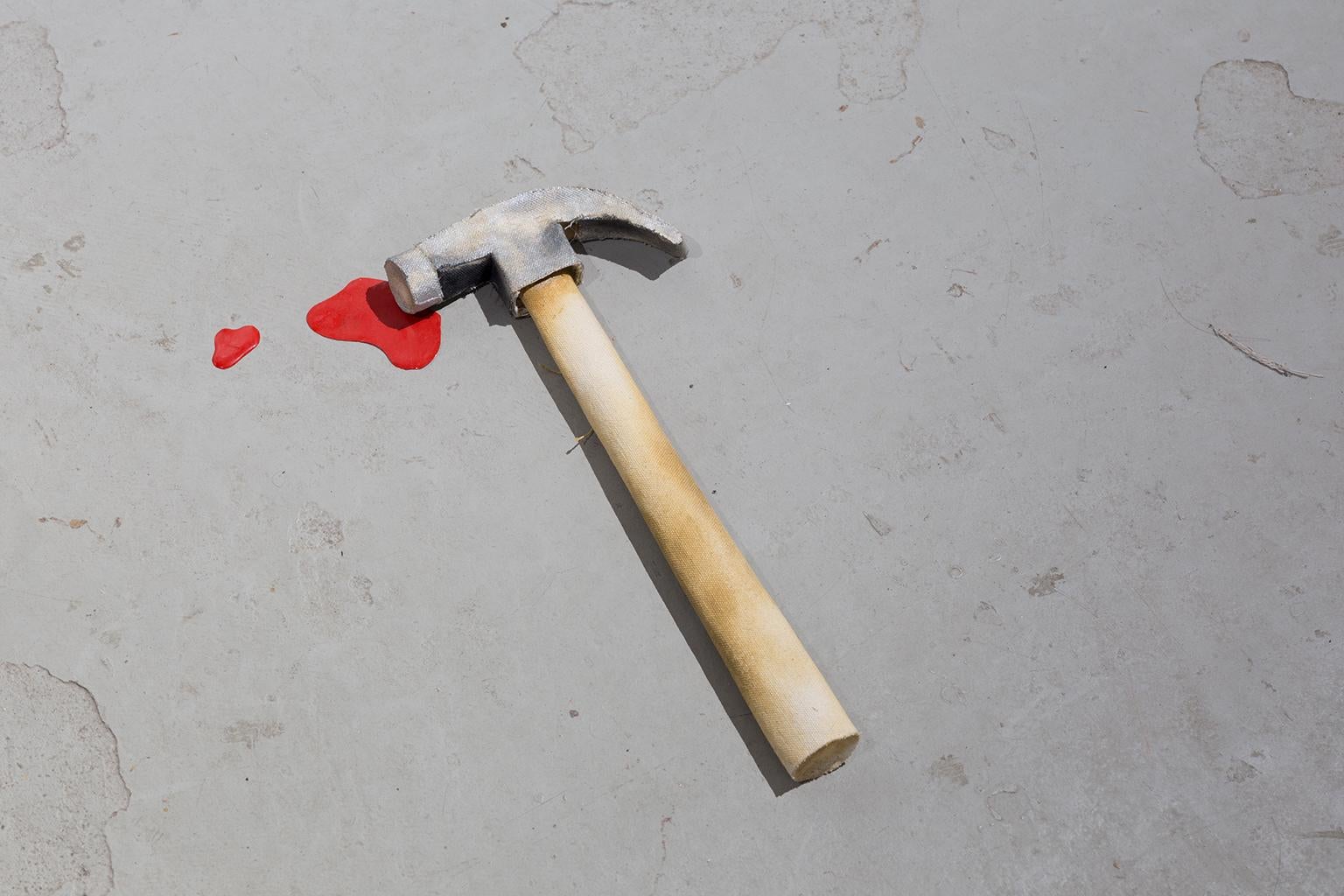Want more images or videos?
Request additional images or videos from the seller
1 of 5
Eric LamontagneGallon de démesure2018
2018
About the Item
Lamontagne has an interest for the conflicting relationship that exists between the end of the landscape and its contemplation, as well as for the so-called death of painting. The parallel between landscape’s decay and painting’s obsolescence nurtured his artistic process. The artist decided to cut right through his landscape paintings and to reuse the cutout pieces from the same canvas into 3D consumer goods. These canvas deductions partially disfigure the painted sceneries. His gesture toward trompe-l’oeil is somewhat reminiscent of the cubist technic of painting objects on multiple angles at once, allowing them to emerge from the surface of the canvas. Here, illusion becomes disillusion.
- Creator:Eric Lamontagne (1966, Canadian)
- Creation Year:2018
- Dimensions:Height: 15 in (38.1 cm)Width: 2.5 in (6.35 cm)Depth: 1 in (2.54 cm)
- Medium:
- Movement & Style:
- Period:
- Condition:
- Gallery Location:Montreal, CA
- Reference Number:1stDibs: LU4763518862
Eric Lamontagne
Interaction with one of Lamontagne’s works is, simply put, a surreal experience. By using one of several points of entrance, viewers are permitted to experience multiple views of combinations of two and 3-dimensional aspects of his work that redefine the rules of space. Whether looking through peep-holes, or in experiencing the final effects of his mise-en-scène, Lamontagne’s work courts the viewer’s curiosity and imagination, inviting them to let go of traditional ways of seeing and to enter into a playful relationship of what is possible. The piecemeal nature of his mise-en scène with the steam locomotive engine, paired with the accompanying audio recalls time gone by. It remains unclear, however whether this is a memory work, or from a parallel, past, or future time. The space itself appears somewhat liquid in that the various elements are capable of pulling even further away from one another, increasing their dissolving aspect. The upper portions of the canvases succeed at further confusing our understanding of this space with their contradictory gravity work. The streaked nude canvas left exposed would have us believe that there is an upward force on the painted image, while the subjects of the images are reacting only to the usual gravitational pulls. To further confound an understanding of the space, it is not clear as to whether the painted images are in the process of dissolving or being created. Like in dreams or memories there is a sense of something being slightly amiss, or askance. Suspended just short of being fully realized or separated from a state of wholeness, the scene is both static and yet there is a heightened awareness of the potentially impending series of motions that would play out. Other glimpses into parallel and alien scenarios are found throughout the exhibit, offering impossible views and playfully prodding the mind to accept or consider other possibilities. In keeping with past works, there is a focus on an interdisciplinary approach that merges and creates new realities as well as allows for a wide range of perspectives- while maintaining a playfulness. The everyday nature of the visual subject is inclusive, cemeteries, studios, countryside, fireplaces, a sunset, their simplicity is instrumental in allowing viewers to focus of the mechanics of navigating and understanding how the artworks inhabit their space, and the relationships that exist between the viewer and any of the given works.
About the Seller
5.0
Vetted Seller
These experienced sellers undergo a comprehensive evaluation by our team of in-house experts.
Established in 1996
1stDibs seller since 2014
96 sales on 1stDibs
- ShippingRetrieving quote...Ships From: Montreal, Canada
- Return PolicyA return for this item may be initiated within 7 days of delivery.
More From This SellerView All
- Se peinturer dans le coinBy Eric LamontagneLocated in Montreal, QuebecLamontagne has an interest for the conflicting relationship that exists between the end of the landscape and its contemplation, as well as for the so-called death of painting. The pa...Category
2010s Contemporary Figurative Sculptures
MaterialsCanvas, Acrylic
- Enfoncer le clouBy Eric LamontagneLocated in Montreal, QuebecLamontagne has an interest for the conflicting relationship that exists between the end of the landscape and its contemplation, as well as for the so-called death of painting. The pa...Category
2010s Contemporary Figurative Sculptures
MaterialsAcrylic, Canvas
- AgrafeuseBy Eric LamontagneLocated in Montreal, QuebecLamontagne has an interest for the conflicting relationship that exists between the end of the landscape and its contemplation, as well as for the so-called death of painting. The pa...Category
2010s Contemporary Figurative Sculptures
MaterialsAcrylic, Canvas
- Hook Ups and Lay UpsBy Cal LaneLocated in Montreal, QuebecLaughter, discomfort, perplexity: these are all plausible reactions to the work by sculptor Cal Lane. The artist’s most recent body of work is an affective assemblage of incongruous parts that, taken together, violate our mental patterns and expectations. Charged with contradictions, metaphor, sexual undertones, and unsettling associations, Lane’s unlikely combinations use absurdity as a way of pointing to western society’s normalized habits and conventions, often with an emphasis on gender and sexuality. For the exhibition Try Me, Lane installs a basketball court in the gallery. The two basketball hoops on opposing walls are embellished with silver-coated frames and lustrous mirrors, which serve as decorative backboards. In place of nets, women’s black lace underwear delicately hang from hoops. A decorative rug stenciled with court lines performs as the court floor. It is a mise-en-scène set in motion by viewer’s reconciliation of the individual parts to the whole, and to their original function. Panties regard themselves in the mirror or perhaps measure up their opponent, which, not without irony, is the mirror image of itself. Themes of gender and sexuality are performed and imagined in the upward voyeuristic gaze of the viewer and the expected swoosh of the ball into the net. This is further elaborated by phallic impressions formed by court lines and their likeness to a work of modernist abstraction—a movement wrought by notions of masculinity. The decorative rug’s connection to femininity and domesticity juxtaposes the rigid geometry. Lane further explores the historical gendering of technology, industry, and war in her series of wallpaper drawings, which depict war submarines on cloud patterned wallpaper. The innocence of the submarine in popular culture and its reality as a phallic war object...Category
2010s Contemporary Figurative Sculptures
MaterialsSteel
- Night ShiftBy Guillaume LachapelleLocated in Montreal, QuebecText by Terence Sharpe There is a moment in Andrei Tarkovsky’s Solaris (1972) when the character Hari commits suicide by drinking liquid oxygen. As she is not actually a human, but an artificial hybrid product of the mysterious planet and the protagonists’ memories, she heals rapidly and is alive again minutes later. Her choice to take her own life is poignant, seemingly the action of a being becoming aware of its hopeless infinitude. Her realization that while the men will die on the space station or elsewhere, her existence is that of immortality, a deeply alienating notion that causes her to seek her own destruction. The Montreal artist Guillaume Lachapelle has one work that prompts a sense of eternal alienation that echoes Hari’s tragedy. The work greets the viewer with a empty doorway flanked by clinically white bookshelves...Category
2010s Contemporary Figurative Sculptures
MaterialsNylon, Glass, Wood, LED Light, Acrylic
- Night shift IIBy Guillaume LachapelleLocated in Montreal, QuebecText by Terence Sharpe There is a moment in Andrei Tarkovsky’s Solaris (1972) when the character Hari commits suicide by drinking liquid oxygen. As she is not actually a human, but an artificial hybrid product of the mysterious planet and the protagonists’ memories, she heals rapidly and is alive again minutes later. Her choice to take her own life is poignant, seemingly the action of a being becoming aware of its hopeless infinitude. Her realization that while the men will die on the space station or elsewhere, her existence is that of immortality, a deeply alienating notion that causes her to seek her own destruction. The Montreal artist Guillaume Lachapelle has one work that prompts a sense of eternal alienation that echoes Hari’s tragedy. The work greets the viewer with a empty doorway flanked by clinically white bookshelves...Category
2010s Contemporary Figurative Sculptures
MaterialsNylon, Glass, LED Light, Acrylic
You May Also Like
- Vapos #1Located in Denver, COElectric Coffin is coded within art history and ideologies from archetypes of mysticism. We explore found truths from modernity and a personal historical perspective. A process-drive...Category
2010s Contemporary Figurative Sculptures
MaterialsCanvas, Glass, Wood, Mixed Media, Acrylic
- Infernus #1Located in Denver, COElectric Coffin is coded within art history and ideologies from archetypes of mysticism. We explore found truths from modernity and a personal historical perspective. A process-drive...Category
2010s Contemporary Animal Paintings
MaterialsCanvas, Glass, Wood, Mixed Media, Acrylic
- Do Not TouchBy Javier CallejaLocated in Palo Alto, CACreated in 2020, this painted resin and steel multiple with accompanying acrylic painting on canvas with original wood crate is signed by Javier Calleja (Spain, 1978 - ) in black ink...Category
2010s Contemporary Figurative Sculptures
MaterialsSteel
- Untitled, Girl Portrait - Contemporary Photography - Painting ObjectBy Magdalena PeszkowskaLocated in Salzburg, ATMagdalena Peszkowska born in 1980 in Gdańsk, Poland. Studied in Department of Painting at Academy of Fine Arts in Gdańsk (1999-2004). Diploma with special recognition in painting in 2004. The character of Magdalena Peszkowska's works Series Stand is like an poetic archive of memories, which call for a classification and reconstruction of the time of childhood and the intense experience of time with everything around it. Gdansk - where the artist comes from - becomes a mythical place, This city, with a very strong symbolic potential inherent in its history, needs editing from a single point of view. Magdalena Peszkowska uses her own photos or those from the family album. She transfers them to gray field blankets and camp beds with her own secret technology Then she paints on the used objects. Many of her objects show figures from the closest circle of Peszkowska, often it is herself, her family or places close to her in Gdansk. Her objects have intentional signs of use. The field blankets have a sewn-in wooden bar to hang them on the wall. The field military beds...Category
2010s Contemporary Figurative Sculptures
MaterialsMetal
- Untitled, City Wolves - Stand Series, Contemporary Photography - Painting ObjectBy Magdalena PeszkowskaLocated in Salzburg, ATMagdalena Peszkowska born in 1980 in Gdańsk, Poland. Studied in Department of Painting at Academy of Fine Arts in Gdańsk (1999-2004). Diploma with special recognition in painting in 2004. The character of Magdalena Peszkowska's works is like an poetic archive of memories, which call for a classification and reconstruction of the time of childhood and the intense experience of time with everything around it. Gdansk - where the artist comes from - becomes a mythical place, This city, with a very strong symbolic potential inherent in its history, needs editing from a single point of view. Magdalena Peszkowska uses her own photos or those from the family album. She transfers them to gray field blankets and camp beds with her own secret technology Then she paints on the used objects. Many of her objects show figures from the closest circle of Peszkowska, often it is herself, her family or places close to her in Gdansk. Her objects have intentional signs of use. The field blankets have a sewn-in wooden bar to hang them on the wall. The field military beds...Category
2010s Contemporary Figurative Sculptures
MaterialsMetal
- Untitled, Sea Ship, Series Stand - Contemporary Photography - Painting ObjectBy Magdalena PeszkowskaLocated in Salzburg, ATMagdalena Peszkowska born in 1980 in Gdańsk, Poland. Studied in Department of Painting at Academy of Fine Arts in Gdańsk (1999-2004). Diploma with special recognition in painting in 2004. The character of Magdalena Peszkowska's works Series Stand is like an poetic archive of memories, which call for a classification and reconstruction of the time of childhood and the intense experience of time with everything around it. Gdansk - where the artist comes from - becomes a mythical place, This city, with a very strong symbolic potential inherent in its history, needs editing from a single point of view. Magdalena Peszkowska uses her own photos or those from the family album. She transfers them to gray field blankets and camp beds with her own secret technology Then she paints on the used objects. Many of her objects show figures from the closest circle of Peszkowska, often it is herself, her family or places close to her in Gdansk. Her objects have intentional signs of use. The field blankets have a sewn-in wooden bar to hang them on the wall. The field military beds...Category
2010s Contemporary Figurative Sculptures
MaterialsMetal






